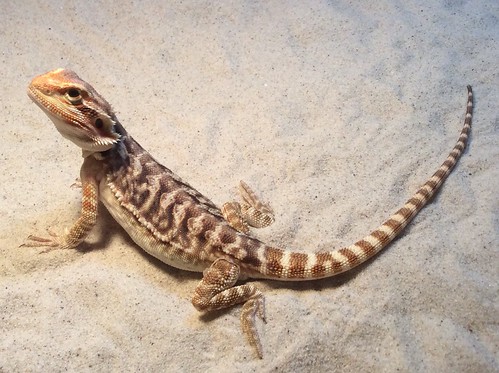Bearded dragons can suffer from various types of tail injuries, including broken tails, tail rot, and bites from other bearded dragons.
Treatment for Bearded Dragon tail injuries typically involves daily soaks and antiseptic ointments.
In the case of tail rot, antibiotics, and antifungal medications may be necessary, along with some proper diet and nutrition.
If a bearded dragon has a broken tail, the first step is to clean the area with a reptile-safe antiseptic solution. Alternatively, you may use a cast, sling, or external splint to immobilize the tail while it heals.
All Types of Bearded Dragon tail injuries
Bearded dragons are resilient creatures, but they can still suffer from various tail injuries if not properly cared for. Some common types of bearded dragon tail injuries include:
Tail rot: This is a serious infection caused by bacteria or fungi, which leads to the decay and necrosis of the tail. Early signs include discoloration, swelling, and a bad smell. If left untreated, tail rot can spread to other parts of the body and can be fatal.
Tail nips: This is a common injury in young bearded dragons when housed together. They may nip at each other’s tails out of curiosity or aggression, causing wounds and sometimes leading to tail rot if left untreated.
Tail fracture: Accidents, such as falls or getting the tail caught in a tight space, can cause fractures in the tail. If the break is severe or not treated properly, it could lead to partial or complete loss of the tail.
Tail autotomy: Bearded dragons have the ability to self-amputate their tails as a defense mechanism, known as autotomy. This usually happens when they feel threatened or in extreme pain. The tail can regenerate to some extent, but it will not be as long or as fully functional as the original tail.
Thermal burns: If the bearded dragon’s basking spot is too hot or they come into contact with a heat source, they can suffer from thermal burns, which can lead to blisters, peeling, and infection if not treated properly.
Abrasions and cuts: Rough surfaces or sharp objects in the enclosure can cause abrasions and cuts on the tail. These injuries can become infected if not cleaned and treated.
Insect bites or stings: Insects, such as crickets, can bite or sting a bearded dragon’s tail, causing swelling, pain, and potential infection.
Shedding complications: If a bearded dragon has an improper or incomplete shed, the retained skin can constrict blood flow to the tail, causing tissue damage and potentially leading to tail rot or necrosis.
What Should Owners Do If Their Bearded Dragon Has a Broken Tail?
If you suspect your bearded dragon has a broken tail, follow these steps:
Clean the Injury
Gently clean the affected area with a mild antiseptic solution to prevent infection. Use a cotton swab or clean cloth to apply the solution and avoid using harsh chemicals that may irritate your pet’s skin.
Splint The Injury
To immobilize the broken tail, use a soft splint made from a cotton pad and medical tape. Secure the splint around the tail, ensuring it’s not too tight to restrict blood flow. This will provide support and stability while the tail heals.
Time To Visit Your Local Veterinarian
A broken tail warrants a visit to your local veterinarian for a professional assessment. They may need to take X-rays to determine the extent of the injury and prescribe appropriate pain relief and anti-inflammatory medications.
Why Is My Bearded Dragon’s Tail Bent?
A bent tail can be a sign of Metabolic Bone Disease (MBD) or tail biting.
Metabolic Bone Disease (MBD)
MBD is a common condition in bearded dragons caused by a lack of calcium, improper UVB lighting, or an imbalanced diet. Signs of MBD include bent or swollen limbs, a soft or rubbery jaw, and lethargy. To prevent MBD, provide your bearded dragon with proper nutrition, UVB lighting, and calcium supplements.
Tail Biting
Tail biting can occur due to stress, boredom, or incorrect tank setup. Provide your bearded dragon with a stimulating environment, including hiding spots, climbing branches, and toys. Monitor your pet’s behavior and consult a veterinarian if the issue persists.
What Do I Do If Your Bearded Dragon Has a Cut on Their Tail?
If your bearded dragon has a cut on their tail, clean the wound with a mild antiseptic solution and apply an antibiotic ointment. Monitor the healing process and consult a veterinarian if signs of infection develop, such as redness, swelling, or discharge.
Bearded Dragon Tail Rot
Tail rot is a severe infection that affects bearded dragons. It occurs when bacteria or fungi enter a wound or injury on the tail, leading to necrosis (tissue death) and possible amputation if left untreated.
What Are the Signs of Bearded Dragon Tail Rot?
Signs of tail rot in bearded dragons include:
- Darkening or blackening of the tail tip
- Swelling, redness, or discharge around the affected area
- Foul odor
- Loss of appetite and lethargy
Can You Treat Tail Rot at Home or Do You Need To Take Your Bearded Dragon to the Vet?
While you can try to treat mild cases of tail rot at home, it’s highly recommended that you consult a veterinarian for proper diagnosis and treatment. Home treatments may include cleaning the affected area with an antiseptic solution and applying an antibiotic ointment. However, severe cases may require professional intervention, such as surgical debridement or amputation.
To prevent tail rot, maintain a clean and hygienic environment for your bearded dragon. Regularly clean their enclosure, provide fresh water, and check for signs of injury or infection. If you suspect tail rot or any other health issue, consult your veterinarian promptly for guidance and treatment.

